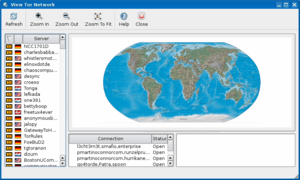Vidalia (software)
 | |
|
Vidalia showing a network map | |
| Original author(s) | Matt Edman, Justin Hipple |
|---|---|
| Developer(s) | Tomás Touceda |
| Initial release | 28 February 2006 |
| Last release | 0.2.21 (3 December 2012) [±] |
| Preview release | 0.3.1 alpha (27 February 2012) [±] |
| Development status | Unmaintained [1] |
| Written in | C++, Qt |
| Operating system | OS X, Microsoft Windows, Unix-like |
| Available in | 30 languages |
|
List of languages Arabic, Basque, Brazilian Portuguese, Bulgarian, Burmese, Catalan, Chinese (simplified), Croatian, Czech, Danish, Dutch, Finnish, French, German, Greek, Hebrew, Hungarian, Indonesian, Italian, Korean, Norwegian, Persian, Polish, Portuguese, Romanian, Russian, Serbian, Spanish, Swedish, Turkish | |
| Type | Anonymity, GUI |
| License | GNU GPL v2 (with OpenSSL exception) |
| Website |
web |

Vidalia is a discontinued[2] cross-platform GUI for controlling Tor, built using Qt. It allows the user to start, stop or view the status of Tor, view, filter or search log messages, monitor bandwidth usage, and configure some aspects of Tor. Vidalia also makes it easier to contribute to the Tor network by optionally helping the user set up a Tor relay.
Another prominent feature of Vidalia is its Tor network map, which lets the user see the geographic location of relays on the Tor network, as well as where the user's application traffic is going.
The name comes from the Vidalia onion since Tor uses onion routing.
Vidalia is released under the GNU General Public License. It runs on any platform supported by Qt 4.2, including Windows, Mac OS X, and Linux or other Unix-like variants using the X11 window system.
See also
References
- ↑ Hahn, Sebastian (9 February 2015). "Removal of Vidalia content from our website". tor-talk. Retrieved 22 March 2015.
- ↑ "Plain Vidalia Bundles to be Discontinued (Don't Panic!) | The Tor Blog". blog.torproject.org. Retrieved 2015-05-22.
